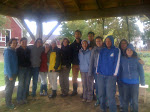Manure, feces, cow pats, cow pies, droppings, horse apples, chicken poop, scat--all of this is a part of life. When making the transition to a farming life, know that this is a regular (so to speak) topic. Just like the new parents who feel that discussing the texture, quantity and frequency of the baby's output is normal conversation, we farmer-trainees think everyone should know about their food animals' manure.
Today's lesson: sheep manure
Here are two examples of sheep manure found in the pasture:
This pellet-like manure to the left looks like very large rabbit pellets and is the sign of a healthy sheep. Our sheep are pasture-grazed for most of their lives and then in the winter, they are fed hay in the barn. When sheep are out grazing, they are susceptible to a stomach parasite. If they have this, their inner eyelid color fades and their manure is not shaped like a pellet.

It is more like the dung on the right, more of a pile or plop than pellets. Nevertheless, good sheep dung is a decent fertilizer. The N-P-K (nitrogen, phosphoric acid, potash) is (.70 .30 .90) ((from http://www.plantea.com/manure.htm)). Don't go putting it straight on your garden, if you happen to have a pile of sheep poop sitting around. Let it "mature" for about 6 months so it won't burn your plants.
 |
| Rabbit tackled by Josh |
Our morning work session involved introduced a ram (Mr. Rabbit) to our flock of ewes. Mr. Rabbit proved true to his name in that as we tried to halter and lead him up to the pasture where the girls were grazing, he hopped sideways and made little forward motion. So Josh wrested him to the ground and we transported the reluctant Romeo by truck. He happily joined the flock and we are planning on an April lambing season if he does his work as expected.
 |
| Looking at "what is underneath" |
We took turns trying to catch and turn a sheep over. Once the sheep is on its back, leaning up against one's leg, they become docile and can be given a check-over, hoof-cleaning, de-worming or any other inspection needed. This is also the position for shearing, a task we will take on in December. The sheep's lanolin glands are easy to find on their bellies. Lanolin protects the sheep's skin from the weather--in particular, it's waxiness helps the wool shed water--and it is also a tick repellant. We were able to feel the waxy clumps and I can imagine a tick ice-skating over the stuff, unable to grab on.
 |
| Justin working the soil with a broadfork. |
Once our work with the sheep was complete, we spread composted manure on our homestead garden. We sprinkled a small amount on the beds and then worked them in with a broad fork. Since animals digest only 10 to 20 percent of the nutrition of its plant food, the animals' excrement is full of nutrition which benefits our next round of growing.
This afternoon, "B Group" helped to harvest some crops for the Farm School community. We picked carrots, turnips, Daikon radish, chard, escarole, kale and lettuce. A round of silly puns began as we washed the vegetables:
Knock knock
Who's there?
lettuce
Lettuce who?
Lettuce in, it's cold out here.
Knock knock
Who's there?
turnip
turnip who?
Turnip the heat, we're still cold
That's
chardly worth laughing about.
Ach, these jokes are
kaling me.
(I've forgotten the "escarole" pun... come back later to see if I can recall it)
More on Manure tomorrow.
 It is more like the dung on the right, more of a pile or plop than pellets. Nevertheless, good sheep dung is a decent fertilizer. The N-P-K (nitrogen, phosphoric acid, potash) is (.70 .30 .90) ((from http://www.plantea.com/manure.htm)). Don't go putting it straight on your garden, if you happen to have a pile of sheep poop sitting around. Let it "mature" for about 6 months so it won't burn your plants.
It is more like the dung on the right, more of a pile or plop than pellets. Nevertheless, good sheep dung is a decent fertilizer. The N-P-K (nitrogen, phosphoric acid, potash) is (.70 .30 .90) ((from http://www.plantea.com/manure.htm)). Don't go putting it straight on your garden, if you happen to have a pile of sheep poop sitting around. Let it "mature" for about 6 months so it won't burn your plants. 




No comments:
Post a Comment